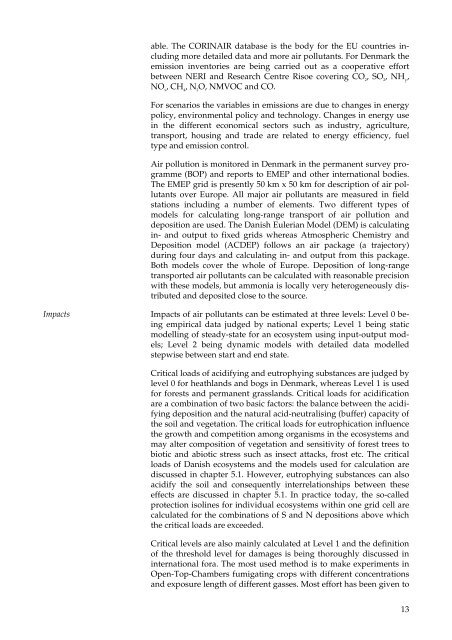Tålegrænser for lufforurening - DCE - Nationalt Center for Miljø og ...
Tålegrænser for lufforurening - DCE - Nationalt Center for Miljø og ...
Tålegrænser for lufforurening - DCE - Nationalt Center for Miljø og ...
You also want an ePaper? Increase the reach of your titles
YUMPU automatically turns print PDFs into web optimized ePapers that Google loves.
Impacts<br />
able. The CORINAIR database is the body <strong>for</strong> the EU countries including<br />
more detailed data and more air pollutants. For Denmark the<br />
emission inventories are being carried out as a cooperative ef<strong>for</strong>t<br />
between NERI and Research Centre Risoe covering CO 2, SO 2, NH y ,<br />
NO x, CH 4, N 2O, NMVOC and CO.<br />
For scenarios the variables in emissions are due to changes in energy<br />
policy, environmental policy and technol<strong>og</strong>y. Changes in energy use<br />
in the different economical sectors such as industry, agriculture,<br />
transport, housing and trade are related to energy efficiency, fuel<br />
type and emission control.<br />
Air pollution is monitored in Denmark in the permanent survey pr<strong>og</strong>ramme<br />
(BOP) and reports to EMEP and other international bodies.<br />
The EMEP grid is presently 50 km x 50 km <strong>for</strong> description of air pollutants<br />
over Europe. All major air pollutants are measured in field<br />
stations including a number of elements. Two different types of<br />
models <strong>for</strong> calculating long-range transport of air pollution and<br />
deposition are used. The Danish Eulerian Model (DEM) is calculating<br />
in- and output to fixed grids whereas Atmospheric Chemistry and<br />
Deposition model (ACDEP) follows an air package (a trajectory)<br />
during four days and calculating in- and output from this package.<br />
Both models cover the whole of Europe. Deposition of long-range<br />
transported air pollutants can be calculated with reasonable precision<br />
with these models, but ammonia is locally very heter<strong>og</strong>eneously distributed<br />
and deposited close to the source.<br />
Impacts of air pollutants can be estimated at three levels: Level 0 being<br />
empirical data judged by national experts; Level 1 being static<br />
modelling of steady-state <strong>for</strong> an ecosystem using input-output models;<br />
Level 2 being dynamic models with detailed data modelled<br />
stepwise between start and end state.<br />
Critical loads of acidifying and eutrophying substances are judged by<br />
level 0 <strong>for</strong> heathlands and b<strong>og</strong>s in Denmark, whereas Level 1 is used<br />
<strong>for</strong> <strong>for</strong>ests and permanent grasslands. Critical loads <strong>for</strong> acidification<br />
are a combination of two basic factors: the balance between the acidifying<br />
deposition and the natural acid-neutralising (buffer) capacity of<br />
the soil and vegetation. The critical loads <strong>for</strong> eutrophication influence<br />
the growth and competition among organisms in the ecosystems and<br />
may alter composition of vegetation and sensitivity of <strong>for</strong>est trees to<br />
biotic and abiotic stress such as insect attacks, frost etc. The critical<br />
loads of Danish ecosystems and the models used <strong>for</strong> calculation are<br />
discussed in chapter 5.1. However, eutrophying substances can also<br />
acidify the soil and consequently interrelationships between these<br />
effects are discussed in chapter 5.1. In practice today, the so-called<br />
protection isolines <strong>for</strong> individual ecosystems within one grid cell are<br />
calculated <strong>for</strong> the combinations of S and N depositions above which<br />
the critical loads are exceeded.<br />
Critical levels are also mainly calculated at Level 1 and the definition<br />
of the threshold level <strong>for</strong> damages is being thoroughly discussed in<br />
international <strong>for</strong>a. The most used method is to make experiments in<br />
Open-Top-Chambers fumigating crops with different concentrations<br />
and exposure length of different gasses. Most ef<strong>for</strong>t has been given to<br />
13

















